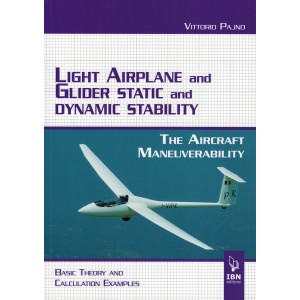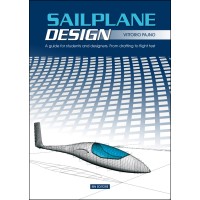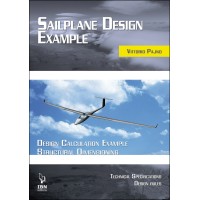Light Airplane and Glider Static and Dynamic Stability
- The Aircraft Maneuverability - Basic Theory and Calculation Examples
Language: English
Author: Vittorio Pajno
Published: 2015
Paperback, 179 pages, several black & white images, many drawings, diagrams, tables, and equations
Dimensions: 6.7 x 9.4 x 0.35 inches (170 x 240 x 9 mm)
Special Package Price - Design Bundle - $10 Savings
Purchase- "Sailplane Design", "Sailplane Design Example", and "Light Airplane and Glider Static and Dynamic Stability", and "Composite Design Manual" at the same time and get $10 off ($50 + $40 + $30 + $80 - $10 = $190). Please order using the "Design Bundle"
Table of Contents (PDF)
Forward - by Vittorio Pajno
The aim of this book is to provide future designers and students of aeronatical engineering with a practical guide to be used in the study of static and dynamic stability on sailplanes and small aircraft.
The proposed calculating method is better suited for sailplanes because of their shapes and good aerodynamics. The effect of propellers on the surfaces is a source of errors in the evaluation of moment contributions and stability derivative, thus a correct evaluation of them is very difficult.
Another problem that is difficult to solve is the evaluation of a lot of theoretical data, which is due to the aeroelastic properties of aircraft. As a matter of fact we consider aircraft as if they were not deformable but we all know that structures are elastic. If we think about it the torsion of sailplanes and the bunding of wing and fuselage at maneuverable speed are relevant owing to the peculiar structural slenderness. As for the coupling of the lateral and directional forces and the consequent motions we must consider that hte static approch is a limited one. A better approach to this problem can be made by considering a dynamic analysis. Sample calculations are intended to explain further the already pragmatic approach used in writing the chapters of this book. I hope that the matter so treated can provide a panoramic view of this part of the design of sailplanes and small aircraft: aircraft stability.
It is recommended that F.A.A. Advisory Circular AC 90-89 A (May 24, 1995) be used as a reference when reading this book. It is available as a free download here:
http://www.faa.gov/documentlibrary/media/advisory_circular/ac%2090-89a.pdf
or here:
https://www.faa.gov/regulations_policies/advisory_circulars/index.cfm/go/document.information/documentID/1027429
If you prefer a printed copy, you can order one here:
http://www.amazon.com/Amateur-Built-Aircraft-Ultralight-Handbook-Advisory/dp/1490418938/ref=tmm_pap_swatch_0?_encoding=UTF8&qid=&sr=
It is also available for Kindle here:
http://www.amazon.com/AMATEUR-BUILT-AIRCRAFT-ULTRALIGHT-HANDBOOK-Administration-ebook/dp/B0051VF0AS/ref=tmm_kin_swatch_0?_encoding=UTF8&qid=&sr=
From Page 169 - by Vittorio Pajno
This book follows the path of other books concerning the design of gliders and light airplanes already published by IBN Editore in Italian and in English.
Writing this book, my intensions were pragmatic but my intention was also to propagate the essential knowledge needed to proceed in this part of aircraft design.
Accordingly the content and figures accompanying the text have been prepared mainly for the use of students and amateur designers. Another intention was to make problems of aircraft stability more understandable, as often, in other much more important works, they are presented in a theoretical way and are sometimes not sufficiently related tot he physical reality and needs of designers. The results of the quartic equation solution very much depend on teh precision of the calculations. Small variations in the numbers chosen for the derivative values lead to significant changes in the results. Once more I must remind readers that precise calculations of the moments of inertia are of paramount importance as well as the estimation of the derivatives. Anyway the last word in aircraft stability is left to flight tests, but this does not mean that designers may skip dynamic stability calculations.
Calculations provide us with tangible, practical and relevant data about safety and it is better to read them before possibly incurring serious mistakes.
I hope, with the publication of this book, in which I direct the interests of designers towards matters of stability, to have contributed to the diffusion of aeronautical technical culture and flight safety.
About the Author
Vittorio Pajno is a Dr. Ing. graduated at the Institute of Technology of Torino, Italy. He was associated as a student in the "Centro di Volo a Vela del Politecnico di Torino" with Prof. Piero Morelli and has published several books about light airplanes and glider design in the Italian language. The book Sailplane Design instead has been published in English.
Among several aeronautical activities, he has organized the Motorless Flight Symposium in Varese and the Sport Aviation Symposium at the Politecnico of Milano. he is the designer of the V 1/2 Rondine, shown on the cover of this book.
The aim of this book is mainly epistemological, but it is also proposed to diffuse the aeronautical culture.
Light Airplane and Glider Static and Dynamic Stability
- Brand: books
- Product Code: Light Airplane and Glider Static and Dynamic Stability
- Availability: In Stock
-
$30.00
Available Options
Related Products
The Glider (L'Aliante)
The Glider (L'Aliante)Author: Stelio Frati198 pagesPublished in 1946 in Italian, Translated to..
$40.00
Sailplane Design
Sailplane Design - 2nd EditionA Guide for Students and Designers, From Drafting to First FlightLangu..
$50.00
Sailplane Design Example
Sailplane Design Example- Design Calculation Example, Structural Dimensioning, Technical Specificati..
$40.00
Composite Design Manual
Composite Design ManualAuthor: Jim MarskePublished: First Edition: 2009, Second Edition: 2017S..
$80.00
















